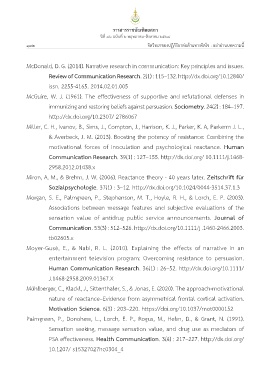Page 140 - 46-2
P. 140
วารสารราชบััณฑิิตยสภา
ปีีที่่� ๔๖ ฉบัับัที่่� ๒ พฤษภาคม–สิิงหาคม ๒๕๖๔
132 จิิตวิิทยาของปฏิิกิิริิยาต่อต้านทางจิิตใจิ : อย่าอ่านบทควิามน้�
McDonald, D. G. (2014). Narrative research in communication: Key principles and issues.
Review of Communication Research. 2(1) : 115–132. http://dx.doi.org/10.12840/
issn. 2255-4165. 2014.02.01.005
McGuire, W. J. (1961). The effectiveness of supportive and refutational defenses in
immunizing and restoring beliefs against persuasion. Sociometry. 24(2) : 184–197.
http://dx.doi.org/10.2307/ 2786067
Miller, C. H., Ivanov, B., Sims, J., Compton, J., Harrison, K. J., Parker, K. A, Parkerm J. L.,
& Averbeck, J. M. (2013). Boosting the potency of resistance: Combining the
motivational forces of inoculation and psychological reactance. Human
Communication Research. 39(1) : 127–155. http://dx.doi.org/ 10.1111/j.1468-
2958.2012.01438.x
Miron, A. M., & Brehm, J. W. (2006). Reactance theory - 40 years later. Zeitschrift für
Sozialpsychologie. 37(1) : 3–12. http://dx.doi.org/10.1024/0044-3514.37.1.3
Morgan, S. E., Palmgreen, P., Stephenson, M. T., Hoyle, R. H., & Lorch, E. P. (2003).
Associations between message features and subjective evaluations of the
sensation value of antidrug public service announcements. Journal of
Communication. 53(3) : 512–526. http://dx.doi.org/10.1111/j .1460-2466.2003.
tb02605.x
Moyer-Gusé, E., & Nabi, R. L. (2010). Explaining the effects of narrative in an
entertainment television program: Overcoming resistance to persuasion.
Human Communication Research. 36(1) : 26–52. http://dx.doi.org/10.1111/
J.1468-2958.2009.01367.X
Mühlberger, C., Klackl, J., Sittenthaler, S., & Jonas, E. (2020). The approach-motivational
nature of reactance–Evidence from asymmetrical frontal cortical activation.
Motivation Science. 6(3) : 203–220. https://doi.org/10.1037/mot0000152
Palmgreen, P., Donohew, L., Lorch, E. P., Rogus, M., Helm, D., & Grant, N. (1991).
Sensation seeking, message sensation value, and drug use as mediators of
PSA effectiveness. Health Communication. 3(4) : 217–227. http://dx.doi.org/
10.1207/ s15327027hc0304_4
2/12/2565 BE 14:48
_22-0789(114-134)7.indd 132 2/12/2565 BE 14:48
_22-0789(114-134)7.indd 132

